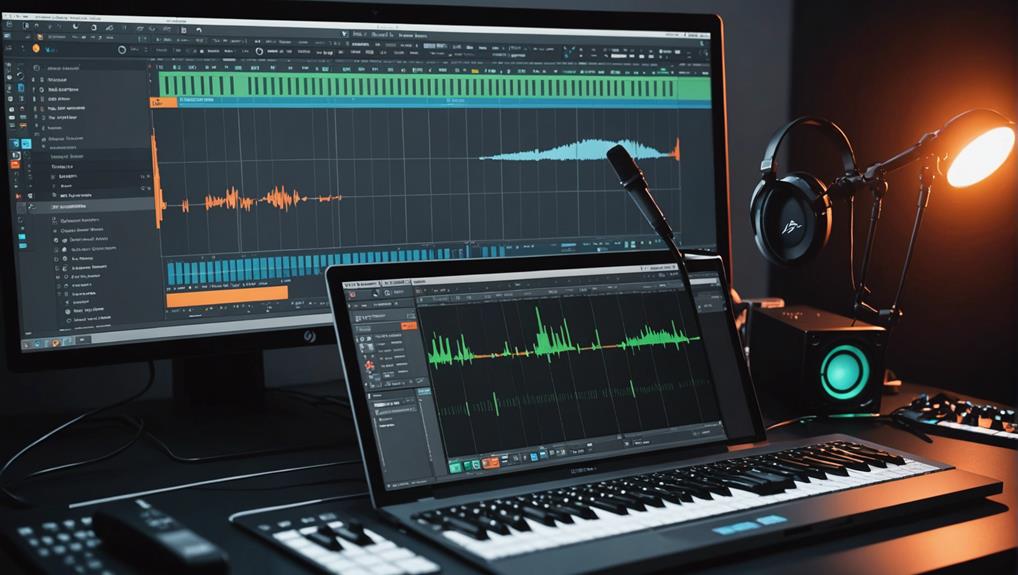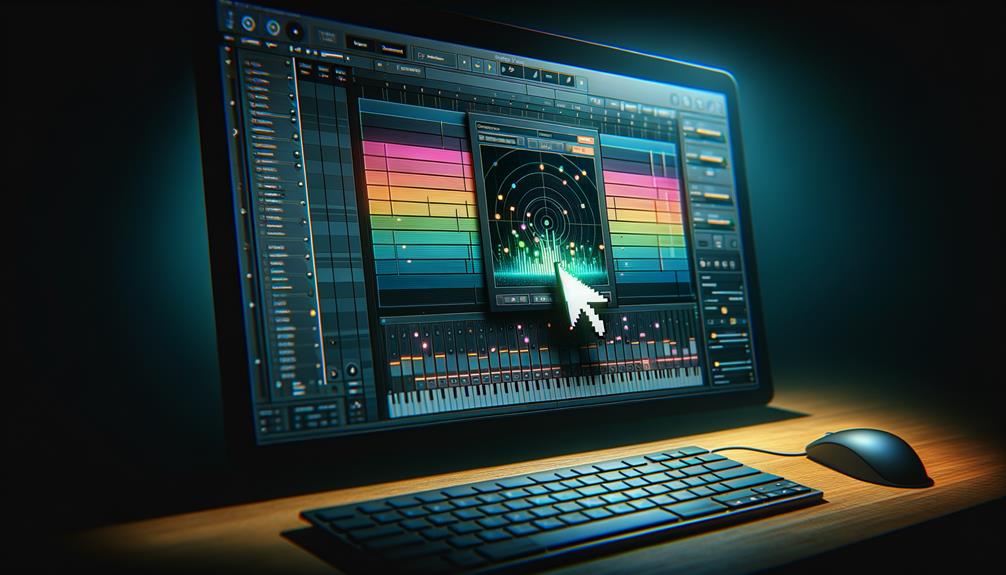To change the time signature in FL Studio, follow these three steps. First, access the time signature settings by going to Options > Project General Settings or by using the transport panel’s display. Next, select the desired pattern and double-click to adjust the numerator and denominator in the time markers section. This modification changes the time signature for that specific pattern while keeping the overall project intact. Finally, verify the adjustments for rhythmic accuracy. Exploring these settings can reveal new creative avenues for your compositions, leading to even more innovative musical possibilities.
Key Takeaways
- Open FL Studio and navigate to Options > Project General Settings to access the time signature settings.
- Locate the time signature display on the transport panel for quick adjustments.
- Double-click the desired pattern to modify its specific time signature settings.
- Adjust the numerator and denominator in the time markers section for your selected pattern.
- Verify the rhythmic integrity by listening to the playback after changing the time signature.
Understanding Time Signatures
While many musicians may instinctively feel the rhythm of a piece, understanding time signatures is fundamental to mastering musical composition. A time signature, typically represented as a fraction (e.g., 4/4, 3/4), indicates both the number of beats in each measure and the type of note receiving one beat.
The top number specifies how many beats are present, while the bottom number identifies the note value that represents one beat. Time signatures are essential for establishing the rhythmic feel and structure of a piece, influencing its overall groove and style. Different time signatures create distinct musical feels that can significantly impact the emotional expression of a composition.
Familiarity with common time signatures, like 4/4 and 3/4, allows musicians to convey specific moods and dynamics, enhancing their storytelling capabilities within various time settings.
Accessing Time Signature Settings
How can you efficiently modify the time signature in FL Studio? To access the time signature settings, navigate to the Options menu and select Project General Settings. Alternatively, for quick adjustments, click directly on the time signature display in the transport panel. The default time signature is usually set to 4/4, but users can select “Set as time signature” to input their specific numerator and denominator. FL Studio allows for multiple time signatures within a single project, with changes automatically saved. Visual indicators in the playlist and piano roll provide real-time updates reflecting any modifications made. Additionally, understanding quantization techniques can enhance your ability to align notes effectively within different time signatures.
| Action | Location | Description |
|---|---|---|
| Access Project Settings | Options > Project General Settings | Modify the time signature settings |
| Quick Access | Transport Panel | Click on the time signature display |
| Set Custom Time Signature | Options > Set as time signature | Input desired numerator/denominator |
| Real-Time Feedback | Playlist/Piano Roll | Visual indicators for time signature changes |
Changing Pattern Time Signatures
To modify a pattern’s time signature in FL Studio, double-click the desired pattern to access its settings and navigate to the time markers section. Here, you can adjust the numerator and denominator to define the new time signature, guaranteeing it aligns with the pattern’s content for accurate playback.
Importantly, changes to the time signature affect only the selected pattern, allowing for targeted control without disrupting the entire project. Utilize the drop-down menu in the pattern window to select specific time signatures, facilitating precise adjustments during composition.
After making the necessary changes, verify that the pattern’s content maintains rhythmic integrity to guarantee a seamless flow within the overall project, enhancing both creativity and technicality in your music production. Additionally, experimenting with various time signatures can inspire unique musical compositions and challenge conventional structures.
Frequently Asked Questions
How to Change Time Signature in FL Studio?
Changing the time signature in FL Studio involves understanding time signature basics and adjusting tempo within the digital audio workspace. Utilize project settings and markers to guarantee rhythmic consistency while achieving desired musical expression throughout your composition.
How Do I Set a Time Signature?
Setting a time signature involves understanding time signature basics, such as numerator and denominator. Common time signature examples include 4/4 and 3/4. Adjusting it influences rhythmic feel, impacting overall time signature effects in musical compositions.
How Do I Change My Time Signature in Reason?
To change your time signature in Reason, navigate to the Song menu for time signature basics and tempo adjustments. Utilize the sequencer track to apply specific changes, enhancing your reason workflow with creative rhythmic variations.
How Do You Change the Duration of Notes in FL Studio?
To effectively modify note duration in FL Studio, utilize techniques such as altering note length via the Piano Roll, adjusting note timing with quantization settings, or applying the ‘Time Stretch’ tool for precision in your compositions.
Conclusion
To sum up, altering time signatures within FL Studio involves a clear understanding of musical structure, accessing the appropriate settings, and applying changes to specific patterns. Mastery of these steps enhances compositional flexibility, allowing for the exploration of diverse rhythmic possibilities. By effectively manipulating time signatures, users can create intricate and dynamic musical pieces that resonate with various styles and genres. This capability ultimately enriches the creative process and broadens the scope of musical expression.
FL Studio provides a great platform for music creators and enthusiasts, offering unlimited possibilities for music creation. If you often use FL Studio to create music and like this software, you can make some Custom Keychains to express your support and love for it. The shape of the keychain can be based on the FL Studio logo design, and then add some style elements you like. Or find inspiration from the music you create. Wear this keychain with you to accompany your music creation journey.



